Huntington Library Collectors' Council Helps Purchase Manuscripts by Award-Winning Travel Writer and Novelist Paul Theroux

SAN MARINO, Calif.—The Huntington Library, Art Collections, and Botanical Gardens announced today that it has acquired the papers of renowned travel writer and novelist Paul Theroux. The acquisition is a substantial addition to The Huntington’s already extensive holdings in travel literature and fiction, and includes notebooks, autograph drafts, and corrected typescript drafts for nearly all of Theroux’s 51 books, along with diaries, short stories, plays, lectures, essays, and correspondence from other noted writers.
Other items acquired at The Huntington’s 19th annual Library Collectors’ Council meeting include the extensive papers of Republican Party founder and Pennsylvania Supreme Court Chief Justice John Meredith Read (1797-1874), a spectacular collection of 19th-century images that trace the history of photographic practice in the American West, an annotated early 15th-century Latin manuscript about the Three Magi, and a volume of notes taken during the lectures of 19th-century French mathematician Augustin-Louis Cauchy.
“This year’s acquisitions are simply off the charts with regard to their research value and the way they complement our existing collections in literature, history, the history of science, and photography,” said David Zeidberg, Avery Director of the Library at The Huntington. “We are immensely grateful to the council members for their incredible generosity.”
The Library Collectors’ Council is a group of 39 families who help support acquisitions. It was formed to augment the collections by helping to purchase materials that the institution otherwise could not afford.
Highlights of the newly purchased materials:
Paul Theroux Collection
In his long and distinguished career, Paul Theroux has explored the far reaches of the globe to produce a body of classic travel books. From his first travel account, The Great Railway Bazaar, through others such as The Old Patagonian Express (nominated for the American Book Award), Dark Star Safari, and The Happy Isles of Oceania, to his most recent book, Deep South, Theroux stands at the forefront of travel writing. The winner of many awards, Theroux received the prestigious Royal Medal from the Royal Geographical Society in May 2015. Previous recipients include Sir Richard Burton, David Livingston, Captain Robert Scott, and Sir David Attenborough.
“The Huntington is a major destination for research on travel and its history,” said Sara “Sue” Hodson, curator of literary manuscripts at The Huntington, noting the vast body of travel accounts in The Huntington’s holdings, dating back to the late middle ages and including such celebrated figures as Sir Richard Burton, T.E. Lawrence (better known as Lawrence of Arabia), as well as more recent writers, such as Jack London and Christopher Isherwood. “The Theroux archive greatly enhances The Huntington’s remarkable strengths in this area,” said Hodson.
Though best known for his travel accounts, Theroux has also produced a large and distinguished body of fiction. Among his best-known novels are Saint Jack and The Mosquito Coast, which was nominated for the American Book Award and won the James Tait Black Memorial Prize.
“Theroux’s novels and short stories are engaging and provocative. Many deal with Americans or Britons living in other societies, experiencing other cultures, and trying to prosper as they encounter sometimes alien ways of life,” said Hodson.
The Mosquito Coast was adapted into a 1986 movie of the same title, directed by Peter Weir and starring Harrison Ford. Theroux’s novels Saint Jack, Dr. Slaughter (released as Half Moon Street), and Kowloon Tong (released as Chinese Box) have also been made into films. London Embassy, a volume of Theroux’s short stories, was produced as a TV miniseries.
The Theroux collection, covering the period from 1965 to 2015, includes a number of unpublished texts and drafts for all but a few of the author’s books, as well as extensive and significant correspondence from the Nobel Prize-winning novelist V.S. Naipaul and many other writers, including Graham Greene, S.J. Perelman, Nadine Gordimer, Margaret Drabble, Iris Murdoch, Stephen Spender, Gore Vidal, Laurens van der Post, Jan Morris, William Styron, and Bruce Chatwin.
Papers of John Meredith Read
The Council also purchased the archive of John Meredith Read (1797-1874), an eminent Pennsylvania jurist, an outspoken opponent of slavery, and a founder of the Republican Party. Having served as the U.S. federal judge for the Eastern District of Pennsylvania, he was nominated for the U.S. Supreme Court in 1845, only to be denied confirmation because of his vocal opposition to slavery.
The collection—comprising eight letterpress books totaling some 4,500 letters, as well as some 500 additional letters, legal papers, and documents—covers the most important period of Read’s career, from 1853 to 1865. The head of a successful law firm, he was a highly respected estate and corporate lawyer, and his clients included leading citizens of Pennsylvania and New Jersey, as well as major railroad and canal companies. In 1854, Read, along with his friend David Wilmot, emerged as a leader of the nascent Republican Party. He was the chief organizer of the first Republican National Convention in Philadelphia in 1856. In 1858, he led Pennsylvania Republicans to their first electoral victory and won his own race for the state Supreme Court in a landslide. This success brought him forward as a candidate for President of the United States, with Abraham Lincoln as his running mate. Early on, however, he threw his support behind Lincoln and campaigned for him in Pennsylvania and New Jersey. During the Civil War, Read served as an advisor to the Lincoln administration, congressional Republicans, and leading Pennsylvania politicians.
The political correspondence in the collection includes unpublished and previously unknown letters to Abraham Lincoln, Charles Sumner, Henry Wilson, Salmon P. Chase, Edwin M. Stanton, Henry Wilson, David Wilmot, Francis Lieber, Nathaniel P. Banks, Simon Cameron, Horace Greeley, William H. Seward, Gideon Welles, and others. The legal papers cover all aspects of Read’s long and distinguished career in law, including his tenure as the Chief Justice of the Pennsylvania Supreme Court.
“This extraordinary archive is an invaluable addition to The Huntington’s famous Lincoln and Civil War collections and greatly expands our collections of 19th-century Americana,” said Olga Tsapina, Norris Foundation Curator of American Historical Manuscripts.
Mautz Collection of History of Photography in the American West
In 1984, Carl Mautz (b. 1942) began buying portraits of everyday people made by 19th-century photographers working in the American West. An attorney turned dealer and publisher, Mautz became intrigued by his encounter with countless first-rate images created by photographers about whom little to nothing was known. This lack of information launched a hunt for unique imprints that became the primary source material for his book Biographies of Western Photographers (1997), an essential reference guide for anyone studying photographic practice in the western United States.
Mautz continued to collect after his landmark publication appeared, resulting in a treasure trove of 7,000 portraits representing thousands of commercial photographers operating in 23 states and territories west of the Mississippi, including Hawaii, between 1860 and 1910.
“The collection is simply one-of-a-kind, providing a mountain of social and historical data to scholars investigating the networks and vectors of visual commerce at a critical place and time in the medium’s history,” said Jennifer A. Watts, curator of photography at The Huntington.
“And the sitters themselves depict a brilliant array of multigenerational and multicultural people who reflect the diverse nature of the frontier and post-frontier American West: soldiers, grandmothers, frontiersmen, babies cradled in their mothers’ arms, workers brandishing the tools of their trade, children holding toys, young women modeling the latest hairstyle and dress. In aggregate, these pictures reflect tastes and trends in clothing, jewelry, and hair—topics of increasing importance to scholars—not to mention the evolving use of posing and props in studio settings,” said Watts.
Latin manuscript about the Three Magi
Written on parchment and produced in England between 1400 and 1450, Historia trium regum tells the tale of three kings: Melchior of Nubia and Arabia, Balthasar of India, and Jaspar of Tharsis—the Three Wise Men of biblical fame.
The story moves beyond the Nativity to account for their return journey, their baptism by St. Thomas, and their establishment of a new kingdom. The kings ruled together for decades and died within months of each other. Centuries later, their relics were moved to their final resting place in the Church of St. Peter in Cologne, Germany, where visitors travel to this day to view their reliquary shrine.
Nearly 700 years ago, the scholar and monk Johannes de Hildesheim (d. 1375) blended biblical studies, 14th-century travel logs, and popular lore to produce Historia trium regum, which became the authoritative history of the three Magi. Within decades, his story was translated from Latin into German, Dutch, Flemish, French, and English. Hildesheim’s Historia trium regum became one of the most widely read devotional texts in medieval Europe.
“No other institution in the U.S. holds a complete 15th-century Latin manuscript of this version of Historia trium regum that was also produced in England,” said Vanessa Wilkie, William A. Moffett Curator of British Historical Manuscripts. “When situated alongside The Huntington’s unrivaled incunabula —books printed before 1501—and medieval manuscript collections, the volume reinvigorates studies of 15th-century devotional texts, allows for comparative analysis between manuscript and print during this pivotal century, provides rare travel accounts of medieval Europe and the Middle East, and contributes—through its 16th-century reader annotations—to the history of early modern and Reformation reading and reader reaction.”
Mathematical lectures of Cauchy
During his lifetime, Augustin-Louis Cauchy (1789-1857) became the leading mathematician in France. Paris was then the center of the mathematical world, and its ?cole Polytechnique in Paris, where Cauchy taught, was the foremost scientific school in Europe. Cauchy’s lectures at the ?cole Polytechnique in the 1820s established a new attitude toward rigor in mathematics and developed many characteristics of 19th-century concepts and methods of proof.
The Council purchased a bound manuscript volume of the only recorded set of notes taken from Cauchy’s first-year undergraduate lectures at the ?cole Polytechnique for the years 1824-25. The manuscript, produced by Cauchy’s student Louis de la Moricière, joins The Huntington’s 40 rare editions of Cauchy’s printed works on mathematics.
“These notes are of considerable historical importance,” said Dan Lewis, chief curator of manuscripts at The Huntington. “Although Cauchy’s lectures on analysis were published in four great treatises—which The Huntington holds in printed form—the content of his lectures evolved significantly during his 15 years of teaching. My own research into this manuscript has shown that its text contains a tremendous amount of material that was never published, at least not in verbatim form; this represents the mathematical seeds, as it were, of the tree into which his lectures would evolve. Moreover, the notes provide a unique insight into Cauchy’s lectures on mechanics, which were never published in any form.”















